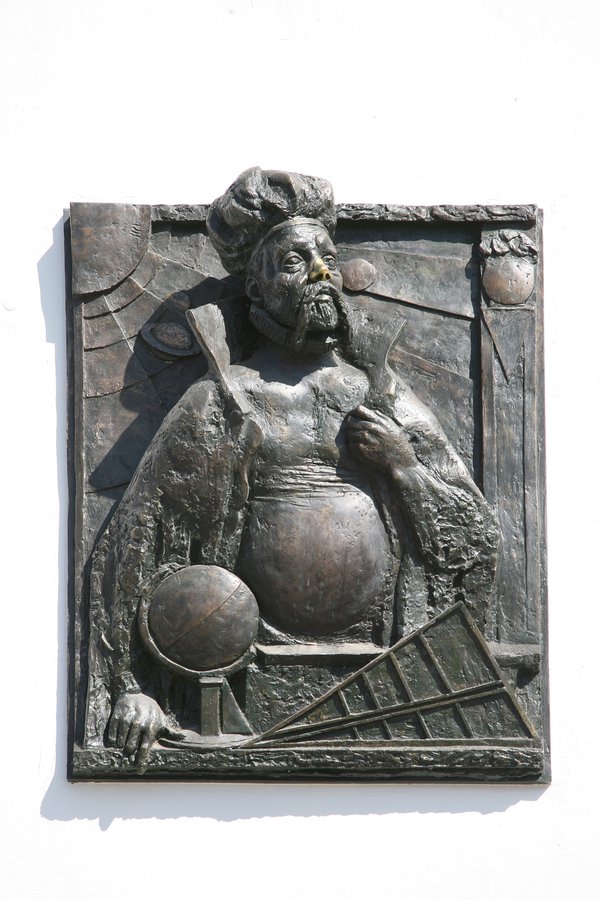The Life of Tycho Brahe
Denmark had been a protestant country since 1536. Nevertheless, superstition was still widespread. The world system of Claudius Ptolemy (ca. 100 - 160 after Christ) with the earth in the centre, surrounded by planet and star spheres, had applied in astronomy for about 1,500 years.
There is a Tycho Brahe sculpture created by Jo Jastram above a sundial on the south side of the Rostocker Volks- und Raiffeisenbank eG at building, located at the square Glatter Aal. It was unveiled on 13 September 1996.
1546
Tycho Brahe (Tyge Ottesen Brahe [Latinized name]) is born on 14 December 1546 at Knutstrup Castle in Skane, now Sweden (part of Denmark at these times), as noble parents’ son.
1559
Enrolled at the University of Copenhagen already at the age of 12 where he starts studying liberal arts. Followed by study visits to Leipzig, Wittenberg, Basel and Rostock.
1560
Brahe observes a partial solar eclipse on 21 August which awakens his interest in astronomy. He decides to dedicate his life to the exploration of space.
1562
Brahe starts studying law in Leipzig. He buys astronomical literature, first smaller instruments and a celestial globe. At first, he focuses on star distance measurements.
1566
His path leads him, via Wittenberg, to the Hanseatic City of Rostock: „Tycho Brahe, natus ex nobili familia in ea parte regni Danici quae dicitur Scania.“ - It is exactly 450 years ago that Tycho enrolls in the university register of the University of Rostock for studying mathematics and astronomy.
He loses parts of his nose when fighting with a fellow-student on 29 December 1566, they are replaced by a prosthesis from then on.
1572
Back in Denmark, Brahe observes an object at the starry sky which is considered as comet by all observers. However, he finds out that it is a new star. Brahe publishes a small writing on his discovery which helps him to win Europe-wide recognition.
1575
Brahe continues his studies in Basel. There, he meets landgrave Wilhelm IV. von Hessen-Kassel (1532 - 1592), who is an enthusiastic astronomer and patron of science himself. Wilhelm recommends the Danish king Frederik II to keep Brahe in Denmark and to employ him at his court.
1576
As court astronomer of the King of Denmark, Frederik II., Brahe is given the island Hven and funding for an observatory building and related instruments. Using these, he is able to observe a comet from 13 November 1577 on. He recognizes a very small parallax (change of the object position when the observer changes his own position) that indicates a large distance.
The comet’s orbit crosses the planets’ spheres here. Brahe recognizes that the comet must come from far outside the moon sphere. He publishes this discovery and, thus, opens a first window for exploring the space.
1588
The funding is drastically cut after Frederik‘s death and Brahe moves via Rostock to Wandsbeck near Hamburg.
1598
Kaiser Rudolph II calls Brahe to Prague and employs him as court mathematician.
1600
Upon Brahe’s request, Johannes Kepler (1571-1630) becomes his assistant.
1601
Brahe dies after a short, severe illness on 24 October 1601, presumably resulting from mercury poisoning.
A grave plate and a tomb at the Teyn Church in Prague remind of the scientific achievements of the Danish astronomer.
Further information [in German] on the life of Tycho Brahe are provided here [PDF]

